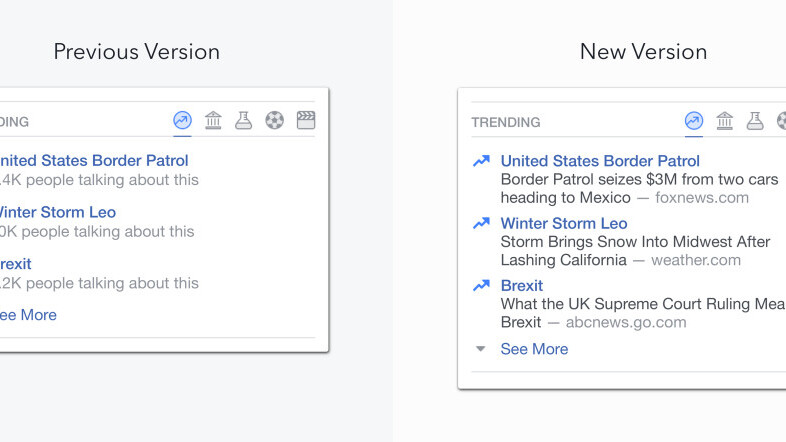
Facebook’s Trending Topics section – and the company’s attempt at personalizing it – has been controversial since its inception. While it’s a useful vignette of the topics people are talking about, Facebook’s attempts at tailoring the section to your own interests were often met with backlash. Now the company has given up on personalization and settled on a more traditional list of the most popular current events.
The update consists of three changes. In Facebook’s own words, these are:
- Trending topics will now feature a publisher headline below each topic name
- An improved system to determine what is trending
- Everyone in the same region will see the same topics
The first change particularly notable. When it last updated the section back in August, the company removed descriptions about the topics. While that helped prevent apparent bias in how events were described, it removed a good deal of context.
Using a publisher headline instead adds extra detail without keeping Facebook accountable for how the events are described. As for which headline is chosen, Facebook says it “is automatically selected based on a combination of factors including the engagement around the article on Facebook, the engagement around the publisher overall, and whether other articles are linking to it.”
That seems to give a distinct advantage to bigger publishers, but we’ll have to see how it plays out over time. Of course, you can still click through to view more articles on the topic from different sources.
On the second change, Facebook says it’s now determining its trending topics from a wider pool of sources. Previously topics may have trended simply because a single post received a ton of engagement. Now Facebook will also analyze how many publishers are posting about the topic, and the engagement for those articles as a whole:
This should surface trending topics quicker, be more effective at capturing a broader range of news and events from around the world and also help ensure that trending topics reflect real world events being covered by multiple news outlets.
The subtext there is that sourcing trending topics from multiple outlets will go a long way in preventing fake news from trending, as it has multiple times.
Finally, by making sure everyone in a region sees the same articles, it makes it easier for the company to roll out trends around the world; it doesn’t need to calibrate its algorithm to assess each individual user’s interest. This should also help combat fake news, as everyone will see the same few selection of trending stories, and make it easier for people in a region to discuss current events. That said, Facebook isn’t saying what constitutes a region; as far as we know it could be as small as a city or as large as a country.
As before, topics will continue to be selected by a magic algorithm, and then reviewed by a team to make sure there isn’t anything fishy happening.
While there are still concerns with the new system – which publishers get shared most often, for instance – it looks like a step in the right direction for a more balanced look at trending topics. Hopefully it will also help curb some fake news along the way.
Get the TNW newsletter
Get the most important tech news in your inbox each week.




